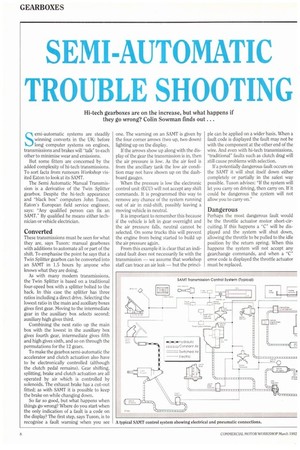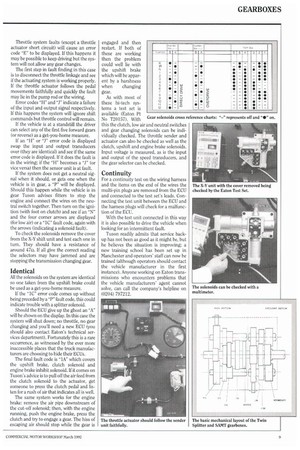SEMI-AUTOMATIC TROUBLE SHOOTING
Page 92

Page 93

If you've noticed an error in this article please click here to report it so we can fix it.
Hi-tech gearboxes are on the increase, but what happens if they go wrong? Colin Sowman finds out ...
Semi-automatic systems are steadily winning converts in the UK: before long computer systems on engines, transmissions and brakes will "talk" to each other to minimise wear and emissions.
But some fitters are concerned by the added complexity of hi-tech transmissions. To sort facts from rumours Workshop visited Eaton to look at its SAMT.
The Semi Automatic Manual Transmission is a derivative of the Twin Splitter gearbox. Despite the hi-tech appearance and "black box" computers John Tuson, Eaton's European field service engineer, says: "Any qualified person can fix an SAMT." By qualified he means either technician or vehicle electrician.
Converted
These transmissions must be seen for what they are, says Tuson: manual gearboxes with additions to automate all or part of the shift. To emphasise the point he says that a Twin Splitter gearbox can be converted into an SAMT in L5 hours by anyone who knows what they are doing.
As with many modern transmissions, the Twin Splitter is based on a traditional four-speed box with a splitter bolted to the back. In this case the splitter has three ratios including a direct drive. Selecting the lowest ratio in the main and auxiliary boxes gives first gear. Moving to the intermediate gear in the auxiliary box selects second; auxiliary high gives third.
Combining the next ratio up the main box with the lowest in the auxiliary box gives fourth gear, intermediate gives fifth and high gives sixth, and so on through the permutations for the 12 gears.
To make the gearbox semi-automatic the accelerator and clutch actuation also have to be electronically controlled (although the clutch pedal remains). Gear shifting, splitting, brake and clutch actuation are all operated by air which is controlled by solenoids. The exhaust brake has a cut-out fitted; as with SAMT it is possible to keep the brake on while changing down.
So far so good, but what happens when things go wrong? Where do you start when the only indication of a fault is a code on the display? The first step, says Tuson, is to recognise a fault warning when you see one. The warning on an SAMT is given by the four corner arrows (two up, two down) lighting up on the display.
If the arrows show up along with the display of the gear the transmission is in, then the air pressure is low. As the air feed is from the ancillary tank the low air condition may not have shown up on the dashboard gauges.
When the pressure is low the electronic control unit (ECU) will not accept any shift commands. It is programmed this way to remove any chance of the system running out of air in mid-shift, possibly leaving a moving vehicle in neutral.
It is important to remember this because if the vehicle is left in gear overnight and the air pressure falls, neutral cannot be selected. On some trucks this will prevent the engine from being started to build up the air pressure again.
From this example it is clear that an indicated fault does not necessarily lie with the transmission — we assume that workshop staff can trace an air leak — but the princi pie can be applied on a wider basis. When a fault code is displayed the fault may not be with the component at the other end of the wire. And even with hi-tech transmissions, "traditional" faults such as clutch drag will still cause problems with selection.
If a potentially dangerous fault occurs on the SAMT it will shut itself down either completely or partially in the safest way possible. Tuson advises: "If the system will let you carry on driving, then carry on. If it could be dangerous the system will not allow you to carry on."
Dangerous
Perhaps the most dangerous fault would be the throttle actuator motor short-circuiting. If this happens a "C" will be displayed and the system will shut down, allowing the throttle to be pulled to the idle position by the return spring. When this happens the system will not accept any gearchange commands, and when a error code is displayed the throttle actuator must be replaced.
Throttle system faults (except a throttle actuator short circuit) will cause an error code "E" to be displayed. If this happens it may be possible to keep driving but the system will not allow any gear changes.
The first step in fault finding in this case is to disconnect the throttle linkage and see if the actuating system is working properly. lithe throttle actuator follows the pedal movements faithfully and quickly the fault may lie in the pump rod or the wiring.
Error codes "H" and "J" indicate a failure of the input and output signal respectively. If this happens the system will ignore shift commands but throttle control will remain.
lithe vehicle is at a standstill the driver can select any of the first five forward gears (or reverse) as a get-you-home measure.
If an "H" or "3" error code is displayed swap the input and output transducers over (they are identical) and see if the same error code is displayed. If it does the fault is in the wiring; if the "H" becomes a "J" (or vice versa) then the sensor unit is at fault.
If the system does not get a neutral signal when it should, or gets one when the vehicle is in gear, a "P" will be displayed. Should this happen while the vehicle is in gear Tuson advises fitters to stop the engine and connect the wires on the neutral switch together. Then turn on the ignition (with foot on clutch) and see if an "N" and the four corner arrows are displayed (for low air) or a "1C" fault code, again with the arrows (indicating a solenoid fault).
To check the solenoids remove the cover from the X-Y shift unit and test each one in turn. They should have a resistance of around 47o. If all give the correct reading the selectors may have jammed and are stopping the transmission changing gear.
Identical
All the solenoids on the system are identical so one taken from the upshift brake could be used as a get-you-home measure.
If the "1C" error code comes up without being preceded by a "P" fault code, this could indicate trouble with a splitter solenoid.
Should the ECU give up the ghost an "A" will be shown on the display. In this case the system will shut down; no throttle, no gear changing and you'll need a new ECU (you should also contact Eaton's technical services department). Fortunately this is a rare occurrence, as witnessed by the ever more inaccessible places that the truck manufacturers are choosing to hide their ECUs.
The final fault code is "lA" which covers the upshift brake, clutch solenoid and engine brake inhibit solenoid. If it comes on Tuson's advice is to pull off the air feed from the clutch solenoid to the actuator, get someone to press the clutch pedal and listen for a rush of air that indicates all is well.
The same system works for the engine brake: remove the air pipe downstream of the cut-off solenoid; then, with the engine running, push the engine brake, press the clutch and try to engage a gear. The hiss of escaping air should stop while the gear is engaged and then restart. If both of these are working then the problem could well lie with the upshift brake which will be apparent by a harshness when changing gear.
9 • —
13 — •
11
—
17
As with most of these hi-tech systems a test set is available (Eaton Pt No T20157). With this the clutch, low air and neutral switches and gear changing solenoids can be individually checked. The throttle sender and actuator can also be checked as well as the clutch, upshift and engine brake solenoids. Input voltage is measured, as is the input and output of the speed transducers, and the gear selector can be checked.
Continuity
For a continuity test on the wiring harness and the items on the end of the wires the multi-pin plugs are removed from the ECU and connected to the test set's leads. Connecting the test unit between the ECU and the harness plugs will check for a malfunction of the ECU.
With the test unit connected in this way it is also possible to drive the vehicle when looking for an intermittent fault.
Tuson readily admits that service backup has not been as good as it might be, but he believes the situation is improving; a new training school has been set up in Manchester and operators' staff can now be trained (although operators should contact the vehicle manufacturer in the first instance). Anyone working on Eaton transmissions who encounters problems that the vehicle manufacturers' agent cannot solve, can call the company's helpline on (0204) 797212.












































































































